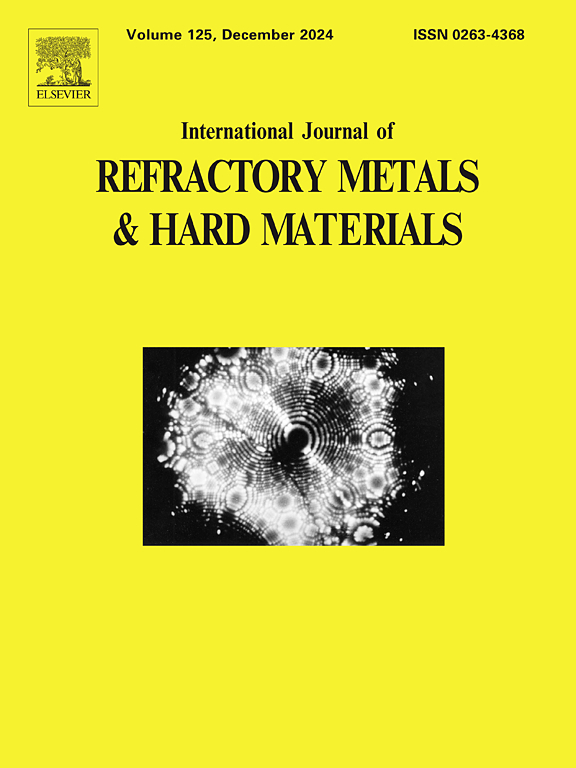硬韧TiSiN/WN涂层的摩擦学和微观力学性能:多层效应的实验分析
IF 4.2
2区 材料科学
Q2 MATERIALS SCIENCE, MULTIDISCIPLINARY
International Journal of Refractory Metals & Hard Materials
Pub Date : 2025-04-29
DOI:10.1016/j.ijrmhm.2025.107212
引用次数: 0
摘要
硬质氮化物涂层由于其优异的机械性能和耐磨性,具有作为切削工具保护层的潜力。为了提高其机械性能、摩擦学性能和高温氧化性能,涂层的结构设计至关重要。研究了磁控溅射法制备的多层WN/TiSiN和单层WN/TiSiN涂层的微观力学和摩擦学性能。我们比较了这些系统的粘附强度、耐磨性和失效机制。多层WN/TiSiN涂层具有优异的附着力和抗裂性。划痕测试证实了黏结-黏着破坏模式,剥落位于界面区域,使涂层能够承受额外的载荷。摩擦学分析揭示了不同涂层的不同磨损机理。虽然WN涂层的磨损率最低(1.3 × 10−6 mm3/Nm),但其附着力差,在应力作用下容易失效,降低了其可靠性。相反,TiSiN涂层表现出更高的磨损率(2.4 × 10−6 mm3/Nm),但通过氧化膜的形成保持了稳定的性能。另一方面,WN/TiSiN多层涂层结合了两种单片层的强度,具有中等磨损率(1.7 × 10−6 mm3/Nm)和低摩擦系数(0.5)。拉曼光谱证实了保护氧化膜的形成,如WO3和TiO2,有助于减少磨损和增强稳定性。本文章由计算机程序翻译,如有差异,请以英文原文为准。

Tribological and micromechanical performance of hard yet tough TiSiN/WN coatings: An experimental analysis of multilayer effects
Hard nitride coatings have the potential to serve as protective layers for cutting tools due to their excellent mechanical properties and wear resistance. To improve their mechanical, tribological, and high-temperature oxidation characteristics, the structural design of the coating is crucial. This study explores the micromechanical and tribological properties of multilayer WN/TiSiN and monolayer WN and TiSiN coatings prepared using magnetron sputtering. We compare the adhesion strength, wear resistance, and failure mechanisms in these systems. The multilayer WN/TiSiN coating demonstrates superior adhesion strength and crack resistance. Scratch tests confirm cohesive-adhesive failure modes with spallation localized to interfacial zones, allowing the coating to withstand extra loading. Tribological analysis revealed distinct wear mechanisms among the coatings. While the WN coating had the lowest wear rate (1.3 × 10−6 mm3/Nm), its poor adhesion and susceptibility to failure under stress reduced its reliability. Conversely, the TiSiN coating exhibits higher wear rates (2.4 × 10−6 mm3/Nm) but maintains stable performance through oxide film formation. On the other hand, the WN/TiSiN multilayer coating combined the strengths of both monolithic layers with moderate wear rates (1.7 × 10−6 mm3/Nm) and a low coefficient of friction (0.5). Raman spectroscopy confirmed the formation of protective oxide films, such as WO3 and TiO2, contributing to reduced wear and enhanced stability.
求助全文
通过发布文献求助,成功后即可免费获取论文全文。
去求助
来源期刊
CiteScore
7.00
自引率
13.90%
发文量
236
审稿时长
35 days
期刊介绍:
The International Journal of Refractory Metals and Hard Materials (IJRMHM) publishes original research articles concerned with all aspects of refractory metals and hard materials. Refractory metals are defined as metals with melting points higher than 1800 °C. These are tungsten, molybdenum, chromium, tantalum, niobium, hafnium, and rhenium, as well as many compounds and alloys based thereupon. Hard materials that are included in the scope of this journal are defined as materials with hardness values higher than 1000 kg/mm2, primarily intended for applications as manufacturing tools or wear resistant components in mechanical systems. Thus they encompass carbides, nitrides and borides of metals, and related compounds. A special focus of this journal is put on the family of hardmetals, which is also known as cemented tungsten carbide, and cermets which are based on titanium carbide and carbonitrides with or without a metal binder. Ceramics and superhard materials including diamond and cubic boron nitride may also be accepted provided the subject material is presented as hard materials as defined above.

 求助内容:
求助内容: 应助结果提醒方式:
应助结果提醒方式:


